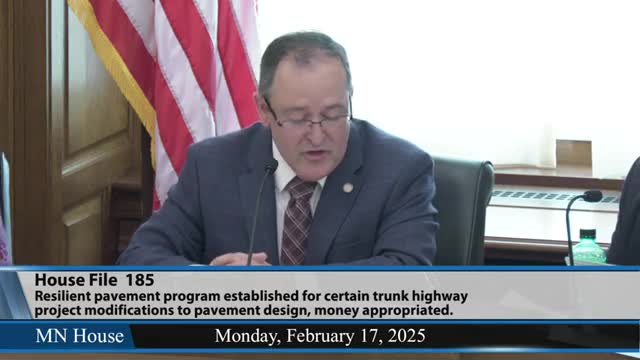Committee hears proposal to up‑scope pavement projects for longer life; supporters say small upcharges yield big life‑cycle savings
February 17, 2025 | 2025 Legislature MN, Minnesota
This article was created by AI summarizing key points discussed. AI makes mistakes, so for full details and context, please refer to the video of the full meeting. Please report any errors so we can fix them. Report an error »

House File 185 was presented Feb. 17, 2025, proposing a resilient paving program to fund targeted increases in pavement thickness and improved foundation specifications that supporters say can double pavement life for a small fraction of total project cost.
Representative Cagle described the bill as an "upscoping" measure to make roads last longer and reduce future maintenance. Dan LeBeau, executive director of the Concrete Paving Association of Minnesota, cited MnDOT life‑cycle analyses and a State Highway 5 Carver County example: increasing pavement design life from 20 to 50 years would cost about $500,000 on an approximately $115,000,000 project, a fractional increase in the total project cost that could more than double pavement longevity.
Civil engineer David White emphasized that inadequate pavement foundation is a leading cause of premature pavement failure and recommended stronger testing and specifications for sub‑foundations. "Small investments in improving that foundation can have disproportionate effects on improving the overall cost effectiveness of pavement systems," White said.
Eric Rudine of MnDOT said the department helped refine the bill language and supported a 50‑year design-life threshold in the draft. MnDOT officials noted districts make project-by-project decisions and that upscoping provides a tool to spend available funds quickly and increase pavement durability where cost effective.
Supporters argued the program would target funds where a modest upcharge would yield clear life‑cycle benefits, require two‑thirds of funds be spent outside MnDOT's metropolitan district, and prohibit use of funds for overhead or staffing. The committee laid the bill over for further consideration.
Representative Cagle described the bill as an "upscoping" measure to make roads last longer and reduce future maintenance. Dan LeBeau, executive director of the Concrete Paving Association of Minnesota, cited MnDOT life‑cycle analyses and a State Highway 5 Carver County example: increasing pavement design life from 20 to 50 years would cost about $500,000 on an approximately $115,000,000 project, a fractional increase in the total project cost that could more than double pavement longevity.
Civil engineer David White emphasized that inadequate pavement foundation is a leading cause of premature pavement failure and recommended stronger testing and specifications for sub‑foundations. "Small investments in improving that foundation can have disproportionate effects on improving the overall cost effectiveness of pavement systems," White said.
Eric Rudine of MnDOT said the department helped refine the bill language and supported a 50‑year design-life threshold in the draft. MnDOT officials noted districts make project-by-project decisions and that upscoping provides a tool to spend available funds quickly and increase pavement durability where cost effective.
Supporters argued the program would target funds where a modest upcharge would yield clear life‑cycle benefits, require two‑thirds of funds be spent outside MnDOT's metropolitan district, and prohibit use of funds for overhead or staffing. The committee laid the bill over for further consideration.
View full meeting
This article is based on a recent meeting—watch the full video and explore the complete transcript for deeper insights into the discussion.
View full meeting
